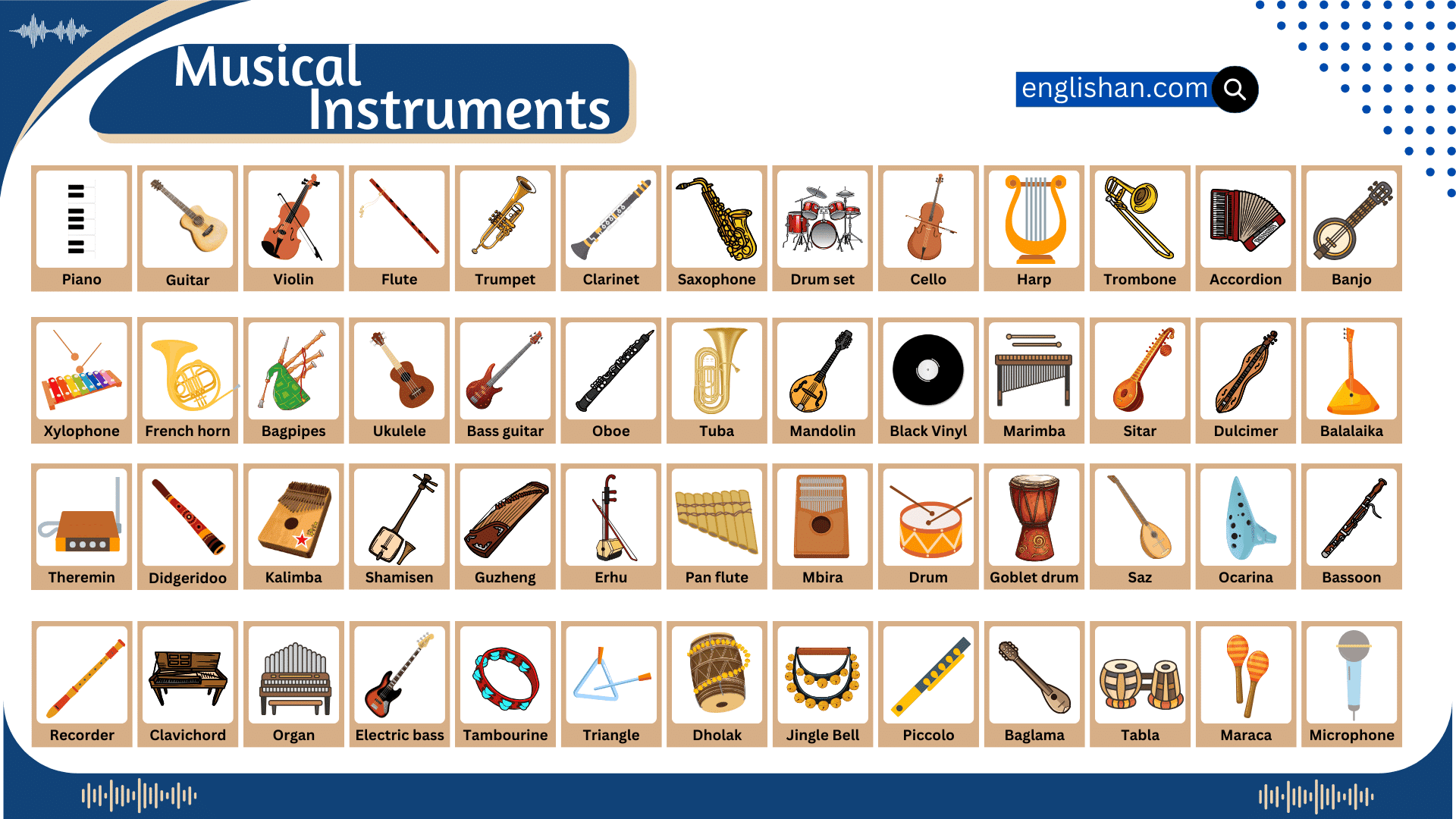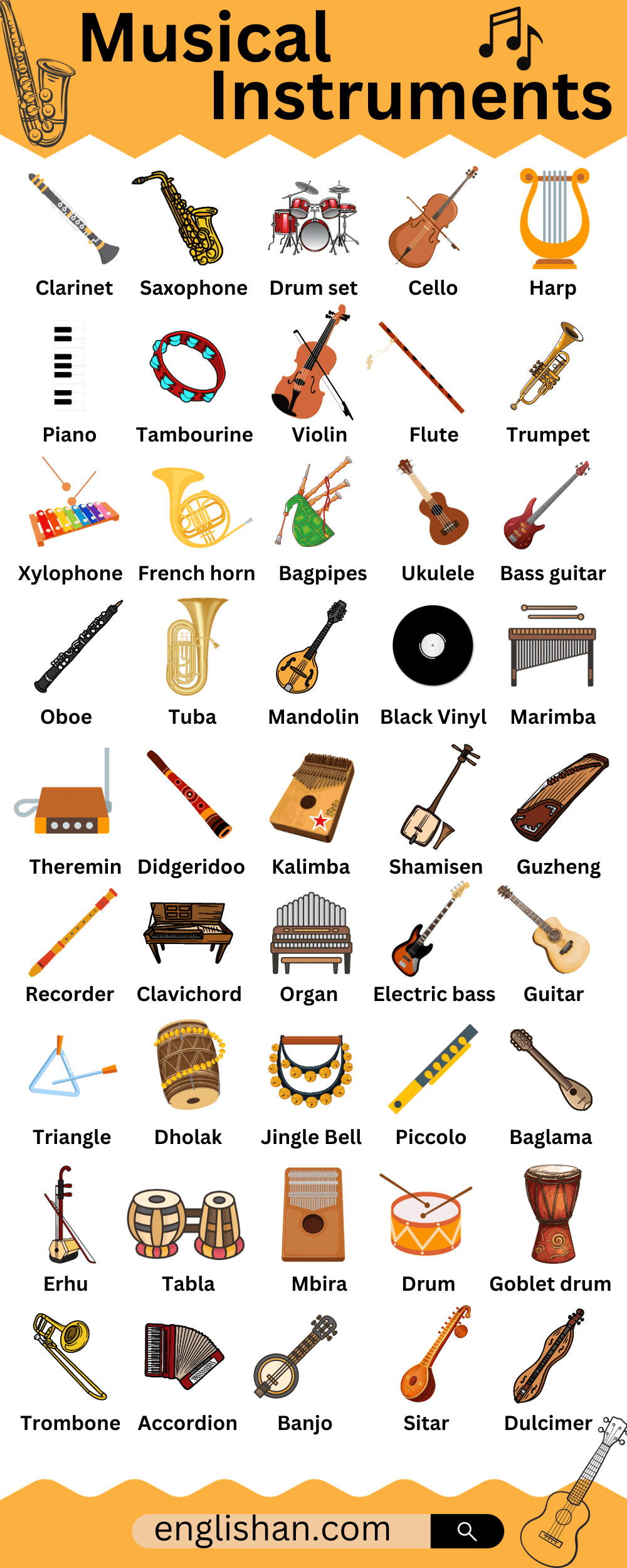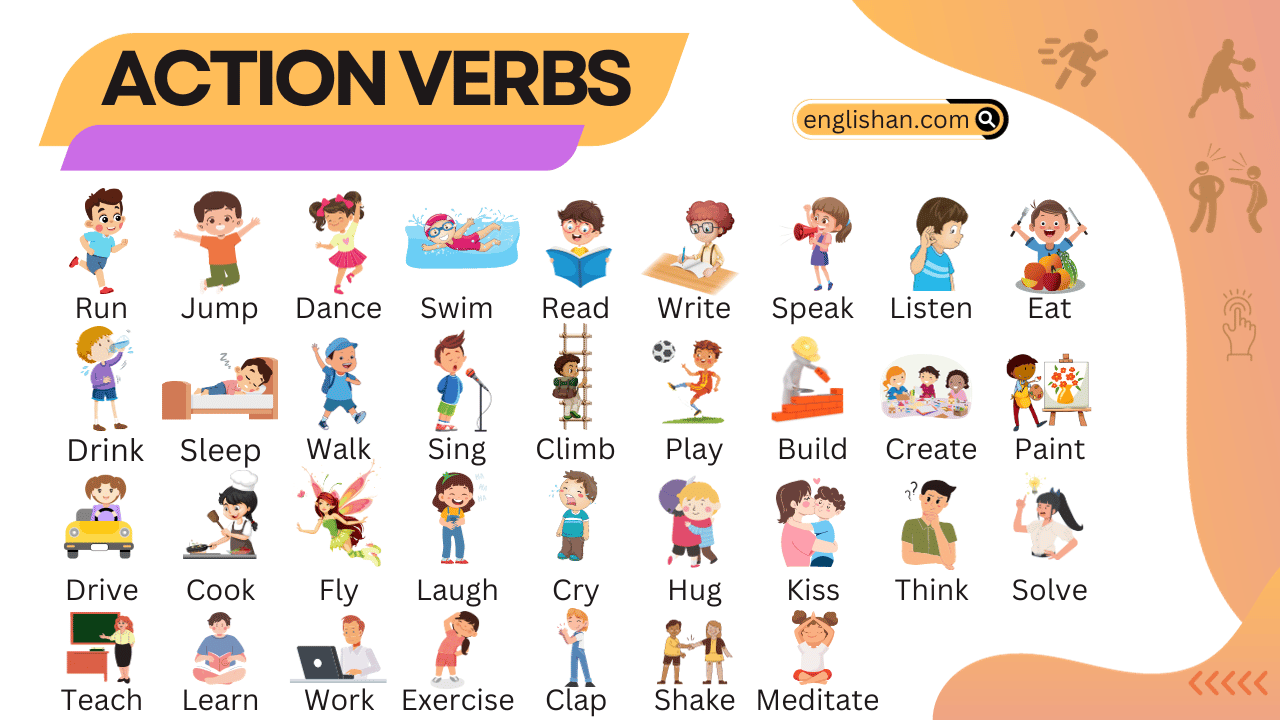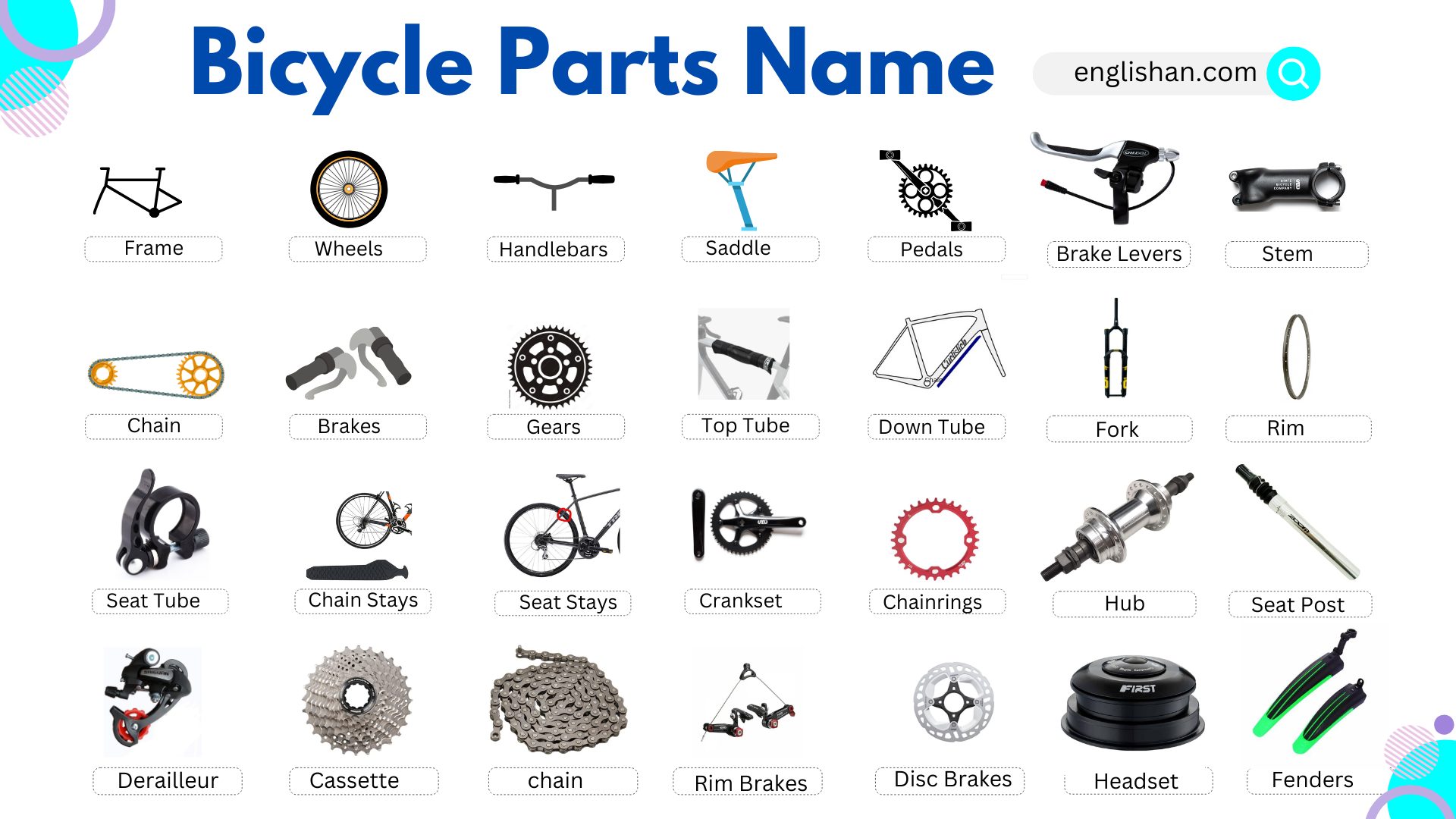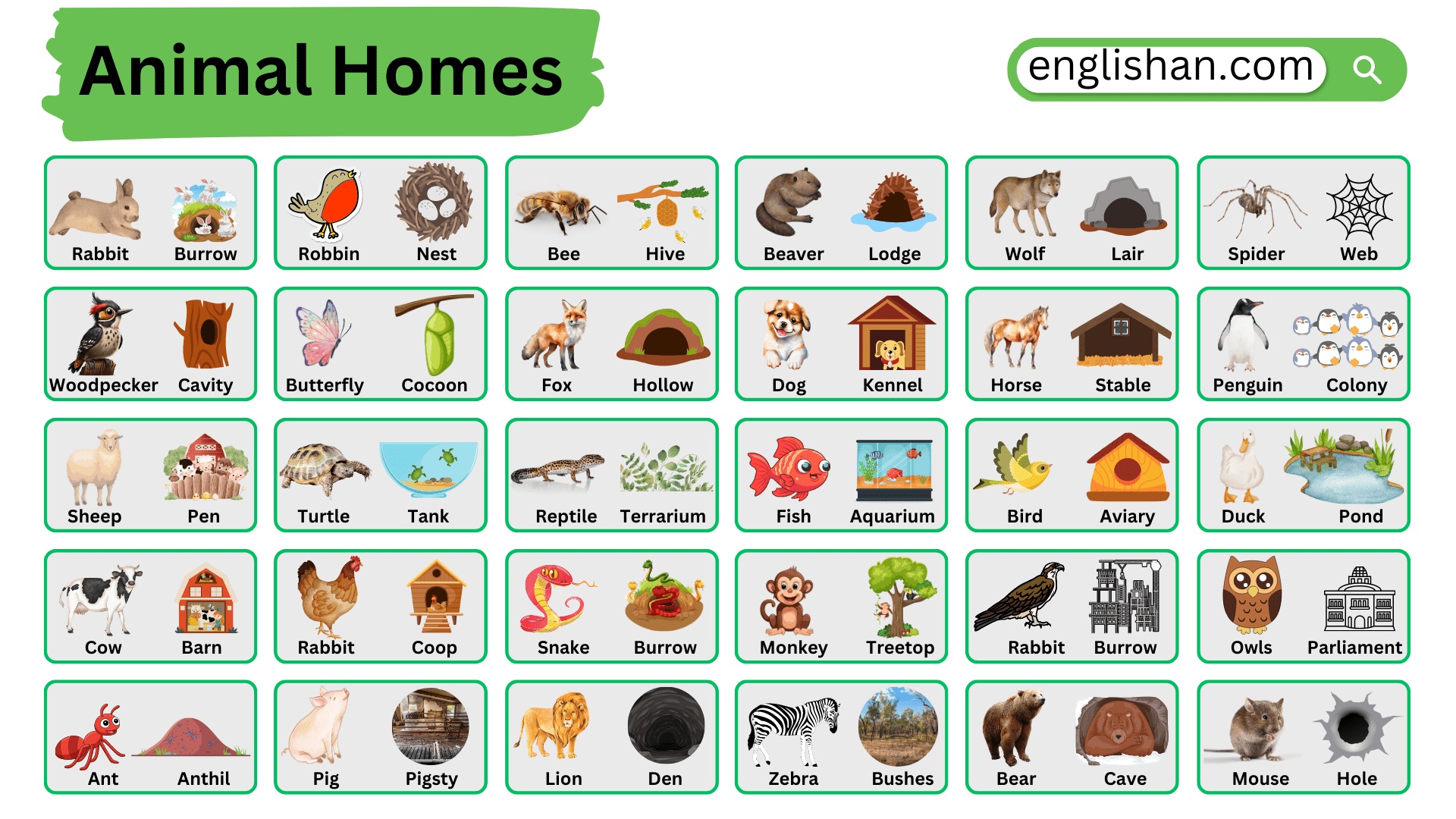Contents
In this blog post, you will learn the names of various musical instruments in English, explained clearly with helpful infographics. Understanding these names can improve your vocabulary and make it easier to talk about music. Whether you are a student or a music enthusiast, these terms are essential for communication.
To learn more vocabulary on different topics, visit our vocabulary category.
List of Musical Instruments Names
| Serial No. | Instrument Name |
|---|---|
| 1 | Accordion |
| 2 | Bagpipes |
| 3 | Banjo |
| 4 | Bassoon |
| 5 | Cello |
| 6 | Clarinet |
| 7 | Double Bass (or Upright Bass) |
| 8 | Drum Kit |
| 9 | Flute |
| 10 | French Horn |
| 11 | Guitar (Acoustic) |
| 12 | Guitar (Electric) |
| 13 | Harmonica |
| 14 | Harp |
| 15 | Harpsichord |
| 16 | Keyboard (Synthesizer) |
| 17 | Koto |
| 18 | Mandolin |
| 19 | Marimba |
| 20 | Oboe |
| 21 | Organ |
| 22 | Pan Flute |
| 23 | Piano |
| 24 | Piccolo |
| 25 | Recorder |
| 26 | Saxophone |
| 27 | Sitar |
| 28 | Tambourine |
| 29 | Trombone |
| 30 | Trumpet |
| 31 | Tuba |
| 32 | Ukulele |
| 33 | Viola |
| 34 | Violin |
| 35 | Xylophone |
| 36 | Zither |
| 37 | Balalaika |
| 38 | Berimbau |
| 39 | Bodhrán |
| 40 | Bouzouki |
| 41 | Castanets |
| 42 | Conga |
| 43 | Cor anglais (or English horn) |
| 44 | Cuatro |
| 45 | Didgeridoo |
| 46 | Djembe |
| 47 | Dulcimer |
| 48 | Erhu |
| 49 | Euphonium |
| 50 | Fiddle |
| 51 | Ghatam |
| 52 | Gong |
| 53 | Guzheng |
| 54 | Harmonium |
| 55 | Hurdy-gurdy |
| 56 | Jew’s Harp |
| 57 | Kalimba (or Mbira) |
| 58 | Lute |
| 59 | Lyre |
| 60 | Mridangam |
| 61 | Ocarina |
| 62 | Pedal Steel Guitar |
| 63 | Pipa |
| 64 | Sarod |
| 65 | Shakuhachi |
| 66 | Shehnai |
| 67 | Soprano Saxophone |
| 68 | Tabla |
| 69 | Taiko Drums |
| 70 | Timpani (or Kettle Drums) |
| 71 | Triangle |
| 72 | Trompe (or Alphorn) |
| 73 | Uilleann Pipes |
| 74 | Vibraphone |
| 75 | Washboard |
| 76 | Zendrum |
| 77 | Zhongruan |
Types of Musical Instruments
Musical instruments can be broadly categorized based on how they produce sound. Let’s break them down into their primary types and provide examples for each.
1. String Instruments (Chordophones)
- Plucked Strings
- Guitar (Acoustic, Electric, Classical)
- Harp
- Mandolin
- Ukulele
- Banjo
- Sitar
- Lute
- Oud
- Zither
- Guzheng
- Koto
- Balalaika
- Bowed Strings
- Violin
- Viola
- Cello
- Double Bass (or Upright Bass)
- Erhu
- Sarangi
- Rebab
- Struck Strings
- Dulcimer
- Cimbalom
- Piano (though it’s also classified as a percussion instrument due to its mechanism)
- Harpsichord
2. Woodwind Instruments (Aerophones)
- Flute (Western Concert, Piccolo, Bamboo, Alto, Bass)
- Recorder
- Clarinet
- Oboe
- Cor anglais (or English horn)
- Bassoon
- Saxophone (Alto, Tenor, Soprano, Baritone)
- Bagpipes
- Shakuhachi
- Pan Flute
- Bansuri
3. Brass Instruments (Aerophones)
- Trumpet
- Trombone
- French Horn
- Tuba
- Euphonium
- Bugle
- Sousaphone
- Cornet
- Mellophone
- Flugelhorn
4. Percussion Instruments (Idiophones & Membranophones)
- Unpitched Percussion
- Drum Kit
- Bongos
- Conga
- Djembe
- Triangle
- Tambourine
- Castanets
- Claves
- Woodblock
- Pitched Percussion
- Xylophone
- Marimba
- Vibraphone
- Timpani (or Kettle Drums)
- Gong
- Bell
- Chimes (or Tubular Bells)
- Hang Drum
5. Keyboard Instruments
- Piano
- Organ (Pipe, Electric)
- Harmonium
- Clavichord
- Synthesizer
- Accordion
- Mellotron
6. Electronic Instruments
- Theremin
- Ondes Martenot
- Electric Guitar
- Electric Bass
- Drum Machine
- Keyboard Synthesizer
- Digital Piano
7. Other/Experimental Instruments
- Didgeridoo
- Kazoo
- Nose Flute
- Jew’s Harp
- Singing Bowl
- Glass Harmonica
8. Hybrid Instruments
- Electric Violin
- Electric Cello
- Keytar
- Electric Harp
Common Musical Instruments
- Piano: A keyboard instrument with hammers striking strings to produce sound.
- Guitar (Acoustic and Electric): A stringed instrument; acoustic uses a hollow body for sound, while electric requires amplification.
- Violin: A stringed instrument played with a bow; known for its high pitch and expressive tone.
- Drums (Drum Kit): A percussion set with varying components like snare, bass drum, and cymbals.
- Flute: A woodwind instrument played by blowing air across a hole.
- Clarinet: A single-reed woodwind instrument with a cylindrical shape.
- Saxophone: A brass-looking woodwind instrument with a single reed and distinctive curved shape.
- Trumpet: A brass instrument with three valves, producing bright, sharp tones.
- Trombone: A brass instrument with a slide mechanism to change pitch.
- Cello: A large stringed instrument played with a bow, producing deeper tones than a violin.
- Bass Guitar: A stringed instrument with typically four strings, providing rhythm and low frequencies.
- Ukulele: A small, four-stringed guitar-like instrument with a light, cheerful sound.
- Harp: A large stringed instrument played by plucking, often associated with angelic music.
- Organ: A keyboard instrument producing sound by pushing air through pipes or using electronic tones.
- Accordion: A portable instrument with a keyboard and bellows, producing sound by pushing air through reed blocks.
- Bassoon: A double-reed woodwind instrument with a low, rich tone.
- Oboe: A double-reed woodwind instrument known for its bright and piercing sound.
- French Horn: A coiled brass instrument with a deep, round tone.
- Tuba: The largest brass instrument, producing the lowest pitch.
- Banjo: A stringed instrument with a circular drum-like body, known for its twangy sound.
- Mandolin: A small, eight-stringed instrument played by plucking, known for its bright tone.
- Harmonica: A small, hand-held wind instrument played by blowing and drawing air through reed chambers.
- Bongos: A pair of connected drums of different sizes, played with the hands.
- Conga: A tall, narrow drum played with the hands, often used in Latin music.
- Viola: Similar to the violin but slightly larger, producing a warmer, deeper tone.
- Xylophone: A percussion instrument with wooden bars struck by mallets.
- Tambourine: A handheld percussion instrument with jingles, often shaken or struck.
- Recorder: A simple woodwind instrument with a whistle-like mouthpiece.
- Triangle: A metal percussion instrument in a triangle shape, struck with a beater.
FAQs
Here’s a short list of musical instruments:
String:
Violin, Guitar, Harp
Wind:
Flute, Saxophone, Trumpet
Percussion:
Drums, Xylophone, Cymbals
Keyboard:
Piano, Accordion
Other:
Bagpipes, Recorder
These are some basic musical instruments!
Here are 12 of the oldest musical instruments:
1. Drums
2. Flute
3. Harp
4. Lyre
5. Sitar
6. Didgeridoo
7. Shofar
8. Tambourine
9. Zither
10. Pan Flute
11. Organ
12. Vielle
These are some of the earliest musical instruments!
Here are 12 of the hardest musical instruments to play:
1. Violin
2. French Horn
3. Oboe
4. Organ
5. Harp
6. Piano
7. Clarinet
8. Trumpet
9. Saxophone
10. Guitar
11. Cello
12. Timpani (Kettledrums)
These instruments are considered difficult because of their techniques, range, or the amount of practice needed to master them.
The most popular musical instrument from the list is the Piano. It’s played in many types of music and is often one of the first instruments people learn.
You May Also Like
